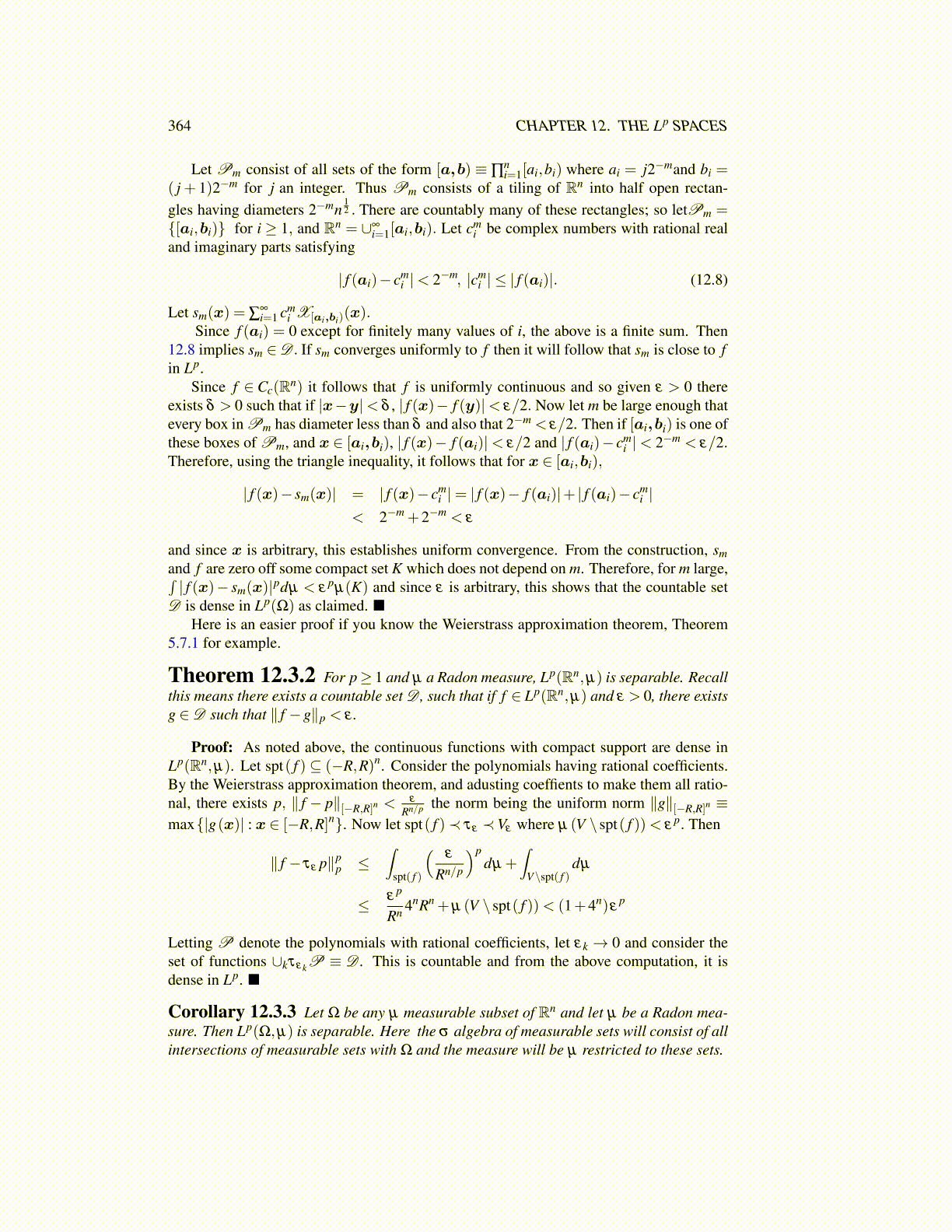
364 CHAPTER 12. THE Lp SPACES
Let Pm consist of all sets of the form [a,b) ≡ ∏ni=1[ai,bi) where ai = j2−mand bi =
( j + 1)2−m for j an integer. Thus Pm consists of a tiling of Rn into half open rectan-gles having diameters 2−mn
12 . There are countably many of these rectangles; so letPm =
{[ai,bi)} for i ≥ 1, and Rn = ∪∞i=1[ai,bi). Let cm
i be complex numbers with rational realand imaginary parts satisfying
| f (ai)− cmi |< 2−m, |cm
i | ≤ | f (ai)|. (12.8)
Let sm(x) = ∑∞i=1 cm
i X[ai,bi)(x).
Since f (ai) = 0 except for finitely many values of i, the above is a finite sum. Then12.8 implies sm ∈D . If sm converges uniformly to f then it will follow that sm is close to fin Lp.
Since f ∈ Cc(Rn) it follows that f is uniformly continuous and so given ε > 0 thereexists δ > 0 such that if |x−y|< δ , | f (x)− f (y)|< ε/2. Now let m be large enough thatevery box in Pm has diameter less than δ and also that 2−m < ε/2. Then if [ai,bi) is one ofthese boxes of Pm, and x ∈ [ai,bi), | f (x)− f (ai)|< ε/2 and | f (ai)− cm
i |< 2−m < ε/2.Therefore, using the triangle inequality, it follows that for x ∈ [ai,bi),
| f (x)− sm(x)| = | f (x)− cmi |= | f (x)− f (ai)|+ | f (ai)− cm
i |< 2−m +2−m < ε
and since x is arbitrary, this establishes uniform convergence. From the construction, smand f are zero off some compact set K which does not depend on m. Therefore, for m large,∫| f (x)− sm(x)|pdµ < ε pµ(K) and since ε is arbitrary, this shows that the countable set
D is dense in Lp(Ω) as claimed. ■Here is an easier proof if you know the Weierstrass approximation theorem, Theorem
5.7.1 for example.
Theorem 12.3.2 For p≥ 1 and µ a Radon measure, Lp(Rn,µ) is separable. Recallthis means there exists a countable set D , such that if f ∈ Lp(Rn,µ) and ε > 0, there existsg ∈D such that ∥ f −g∥p < ε .
Proof: As noted above, the continuous functions with compact support are dense inLp(Rn,µ). Let spt( f ) ⊆ (−R,R)n. Consider the polynomials having rational coefficients.By the Weierstrass approximation theorem, and adusting coeffients to make them all ratio-nal, there exists p, ∥ f − p∥[−R,R]n < ε
Rn/p the norm being the uniform norm ∥g∥[−R,R]n ≡max{|g(x)| : x ∈ [−R,R]n}. Now let spt( f )≺ τε ≺Vε where µ (V \ spt( f ))< ε p. Then
∥ f − τε p∥pp ≤
∫spt( f )
(ε
Rn/p
)pdµ +
∫V\spt( f )
dµ
≤ ε p
Rn 4nRn +µ (V \ spt( f ))< (1+4n)εp
Letting P denote the polynomials with rational coefficients, let εk → 0 and consider theset of functions ∪kτεkP ≡ D . This is countable and from the above computation, it isdense in Lp. ■
Corollary 12.3.3 Let Ω be any µ measurable subset of Rn and let µ be a Radon mea-sure. Then Lp(Ω,µ) is separable. Here the σ algebra of measurable sets will consist of allintersections of measurable sets with Ω and the measure will be µ restricted to these sets.